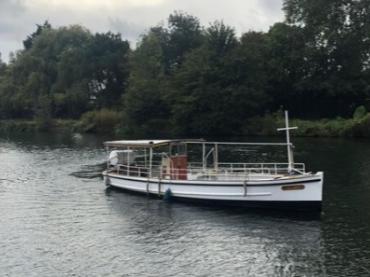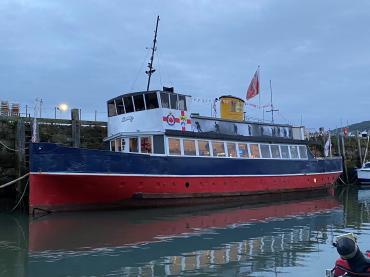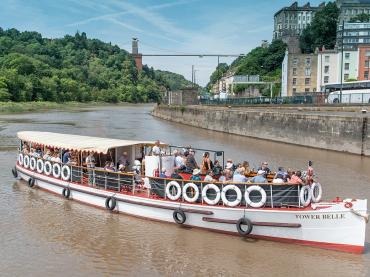


Previous names
- 1935 - 1976 Queen Mary II
Details
Construction
Dimensions
History
Built in 1933 by W Denny Brothers of Dumbarton for Williamson-Buchanan Steamers (which were bought by the London Midland & Scottish Railway in 1935) and launched as QUEEN MARY, this is a steel-hulled vessel built to carry mail and passengers out of the River Clyde to ports on the west coast of Scotland. She was powered by three steam turbine engines propelling triple screws. The contract price was £61,000, and the ship was delivered on time and launched on 30 March 1933.
During the Second World War, QUEEN MARY II was painted naval grey and maintained the Gourock to Dunoon service for over six years, also serving as a tender for ocean-going vessels. From 1943, she was owned and operated by the Caledonian Steam Packet Co. Ltd, coming under the auspices of Caledonian MacBrayne in 1973. Withdrawn from service in 1977, she was owned by Glasgow City Council from 1978 to 1980 and intended for a Clyde maritime museum project, which was abandoned on financial grounds. She was moored at various London docks between 1981 and 1987 until purchased and converted to a bar and restaurant located by Waterloo Bridge in central London. Her machinery has been removed, although two of the steam turbines are in collections at the Scottish Maritime Museum and Science Museum, London.
In 2016, she was successfully towed back to the Clyde and is currently docked in Glasgow. Since rescuing the vessel from being scrapped, in 2015, "Friends of TS Queen Mary" have so far raised and invested £4million in the project to restore the vessel as a heritage destination and education centre, moored at Glasgow Science Centre on the River Clyde. In March 2022, Patron of "Friends of TS Queen Mary" the Princess Royal announced that instead of becoming a static exhibit, the ship will be restored to sail on the Clyde once more. It is planned she will return to sail in summer 2025.
Significance
- What is the vessel’s ability to demonstrate history in her physical fabric?
Evidence for designs, functions, techniques, processes, styles, customs and habits or uses and associations in relation to events and people. How early, intact or rare these features are may impact on significance.
TS QUEEN MARY is the last surviving example of her class worldwide and one of the few remaining passenger ships of any class to have been built with steam turbines. She served in the same fleet as TS KING EDWARD (1901-1951), the world's first steam-turbine-powered passenger vessel and was built on the strength of this vessel’s success, being the third and largest of her type constructed at William Denny's yard for Williamson-Buchanan Steamers.
In the 1980s, TS QUEEN MARY was converted into a hospitality venue, resulting in drastic fabric alterations. Since her return to Glasgow in 2016, extensive work has begun on the structure, with interiors dating from the London era entirely removed. The hull has been stripped back to bare steel, repaired, fitted with new pine belting and repainted. The boat deck, made of Burmese teak, has survived throughout the ship's career and has now been restored. The wooden wheelhouse was added in 1948. A glass panel survives from the original build: it shows the Williamson-Buchanan house flag with its crescent moon and star, surrounded by the words "Queen Mary" and "Glasgow". There were originally two of these. Another survival is the brass plaque recording the details of the transaction with Cunard when the vessel's name was changed to QUEEN MARY II.
Several changes have happened to the funnels. In 1957, the ship was converted from coal to oil and fitted with a new water tube boiler that required only one exhaust. Her original two funnels were removed and replaced with a single, very modern-looking funnel. The tonnage was thus increased to 1,014 but the passenger complement reduced to 1,820. During the early 1980s, the ship was moved to the Thames and in preparation for her use as a bar and restaurant, the turbines were removed, along with the 1957 funnel. Two funnels (narrower in diameter than the originals) were installed, together with a single mast. The restaurant opened in 1988 and the funnels were subsequently painted and repainted in various colour-schemes. These two funnels remain.
2. What are the vessel’s associational links for which there is no physical evidence?
Associations with people or places. Off-ship research.
TS QUEEN MARY holds a prominent place in Glasgow's social history and is an iconic vessel for the city with a strong Scottish significance. Originally certificated to carry 2,086 passengers, she was the largest ship ever built for the excursion trade on the Clyde. From 1933 until 1977, she took many hundreds of thousands of daytrippers and holidaymakers from the city to resorts such as Dunoon, Largs, Bute and Arran. A trip "doon the watter" was a highlight of the summer for Glaswegians and she became known simply as “the Glasgow Boat”. TS QUEEN MARY also carried special groups: for instance, members of the Clyde Navigation Trust inspecting river works in September 1935, representatives of the international press attending the Empire Exhibition in May 1938, and employees of the James Templeton carpet company celebrating its centenary in May 1939.
TS QUEEN MARY has a variety of royal, political and celebrity associations. With the approval of Buckingham Palace, she was named for Mary of Teck, wife of George V. At the launch on 30 March 1933, the ceremony was performed by Lady Colquhoun of Luss (champion golfer and niece of former Prime Minister Asquith) and her husband Sir Iain Colquhoun, 7th Baronet, gave a speech. In 1934, Sir Percy Bates, chairman of Cunard, corresponded with Edgar Macfarlane of Williamson-Buchanan to negotiate the release of the name Queen Mary for the use of Cunard's new liner. Macfarlane agreed to rename his Clyde steamer TS QUEEN MARY II with effect from the spring sailings of 1935. He further agreed to keep the name chosen for the liner secret until the launch date in September 1934, at which the TS QUEEN MARY would serve as a tender.
In the 1940s, TS QUEEN MARY hosted some of its most distinguished guests. Eleanor Roosevelt was on board on 11 November 1942. She was one of a number of government and royal figures who, during wartime visits to the Clyde, were taken back to their liners by TS QUEEN MARY. On 8 October 1946, Queen Elizabeth with her daughters Princess Elizabeth and Princess Margaret, sailed from Greenock on the TS QUEEN MARY to join the Cunard liner RMS QUEEN ELIZABETH for her first official speed trials. Thousands assembled at Greenock and Gourock to greet the royal family.
Prominent politicians and aristocrats who stepped aboard included: King George VI; Anthony Eden; Viscount Montgomery of Alamein; Lord Mountbatten of Burma; Edward Bruce, 10th Earl of Elgin; Sir Daniel Macaulay Stevenson; Vice-Admiral Sir John Roxburgh; Sir Charles G. MacAndrew; and Sir George Arthur Mitchell. In the entertainment world, the music hall star Sir Harry Lauder sailed on the ship, the actor Roddy Macmillan renamed her QUEEN MARY (without the numeral) in 1976, the comedian and actor Robbie Coltrane OBE was the patron of "Friends of the TS Queen Mary" until his death in 2022, and the actor Sam Neill OBE is the current patron. Several films have included scenes on the ship; most recently Now You See Me 2 (2016).
Surviving documentation includes a range of newspaper and archive sources. For instance, the William Denny papers (UGD 3) in the shipbuilding collections at the University of Glasgow, includes cost estimates, cost books, contract envelopes, correspondence, and sailing brochures. Some technical and design records are held at the National Archives, Kew. Material relating to the name change and Cunard's QUEEN MARY is in the University of Liverpool's Cunard collection. Records of the Clyde Navigation Trust are at Glasgow City Archive. One of the original ship’s turbines is in preservation at the Scottish Maritime Museum, Irvine and the other at the Science Museum.
TS QUEEN MARY was recorded on the National Register of Historic Vessels in 1996 with National Historic Fleet status. As a sole survivor of her type, she is redolent of the traditions of Clyde shipbuilding in the steam era, as well as of the heritage of pleasure cruising in the west of Scotland.
3. How does the vessel’s shape or form combine and contribute to her function?
Overall aesthetic impact of the vessel, her lines, material she was built from and her setting. Does she remain in her working environment
Powered by steam turbine engines, TS QUEEN MARY demonstrated advantages over the paddle steamer in her passenger carrying capacity in terms of speed, smoothness, stability and fuel economy. Her primary function until 1977 was river cruising although she was also at times used as a tender for ocean liners. The shape of the riveted steel hull remains unchanged since build. Its deep draught of 3.8m meant that TS QUEEN MARY could not be used as a minesweeper during World War II, and so instead was assigned to ferry and tender work.
TS QUEEN MARY has an unusually extensive deck and passenger space with the 630m square boat deck built as a widespread promenade which passengers could walk all the way around, thanks to a viewing area forward of the bridge. With its 35-foot beam, the ship was wider than any of the other turbine steamers. An unusual feature, in comparison with earlier Clyde steamers, was the positioning of the dining saloon forward of the engines rather than at the stern. This meant it had a particularly fine outlook and diners experienced less vibration. The distinctive solid bulwarks (still present) make the bow area less draughty than those on similar vessels.
The ship's spacious decks, indoor hospitality spaces, and entertainment (such as musicians) were designed to give an experience of glamour and luxury to ordinary working people. The original fit-out and furnishing was upscale, including teak deck seats, mahogany saloon furniture, an oak-panelled smoking room, and Bentwood and Lloyd Loom chairs. The TS QUEEN MARY had two classes of accommodation up until 1950 and boasted a waiter-service restaurant until 1972.
Aesthetically, TS QUEEN MARY is an impressive and attractive ship, with her profile now returned much closer to that of her original design. Today, she is afloat, docked on the Clyde in the area where she used to operate. Tours are regularly available when works allow and she is due to resume sailing in 2025.
Sources:
This statement draws on research conducted as part of the Ocean Modern project https://oceanmodern.gla.ac.uk/
Author:
Faye Hammill and Iain Sim, January 2023
Sources
The Scotsman: New Clyde Steamer: Launch of the Queen Mary.p7, 31 March 1933
The Scotsman: Clyde Navigation Trust: Inspection of River Works. p8, 11 September 1935
The Scotsman: Empire Exhibition to be Closed To-morrow. p16, 7 May 1937
Orr, Richard: Queen Mary, Caledonian MacBrayne, 1976.
Ships Monthly: Still in Steam: Queen Mary pp30-33, September 1977
Sullivan, Dick:Old Ships, Boats and Maritime Museums, Coracle Book 1978
Ships Monthly: Dining Afloat: A review of Britain's floating restaurants pp19-21, December 1990
Brouwer, Norman J, International Register of Historic Ships, Anthony Nelson, Edition 2 1993
Duncan Graham, Wilson Neil: Sunset on the Clyde: The Last Summers on the Water 1993
Orr, Richard M: Aboard Queen Mary II: A Purser's Life on the Glasgow Boat.The Grimsay Press,2011.
Denny, Robin (compiler). Friends of TS Queen Mary,.TS Queen Mary: Official 85th Anniversary Book 2018
BBC News Online: Princess Royal backs Glasgow's TS Queen Mary restoration
https://www.bbc.co.uk/news/uk-scotland-glasgow-west-47515176 11 March 2019
Contract Envelopes - William Denny & Brothers papers
Shipbuilding collections, University of Glasgow Archive Services UGD 3/5/0643
Quinn, Iain: TS Queen Mary: Key Milestones
Clyde River Steamer Club website. No date.
https://crsc.org.uk/archive/special-features/queenmary/
Own this vessel?
If you are the owner of this vessel and would like to provide more details or updated information, please contact info@nationalhistoricships.org.uk
















